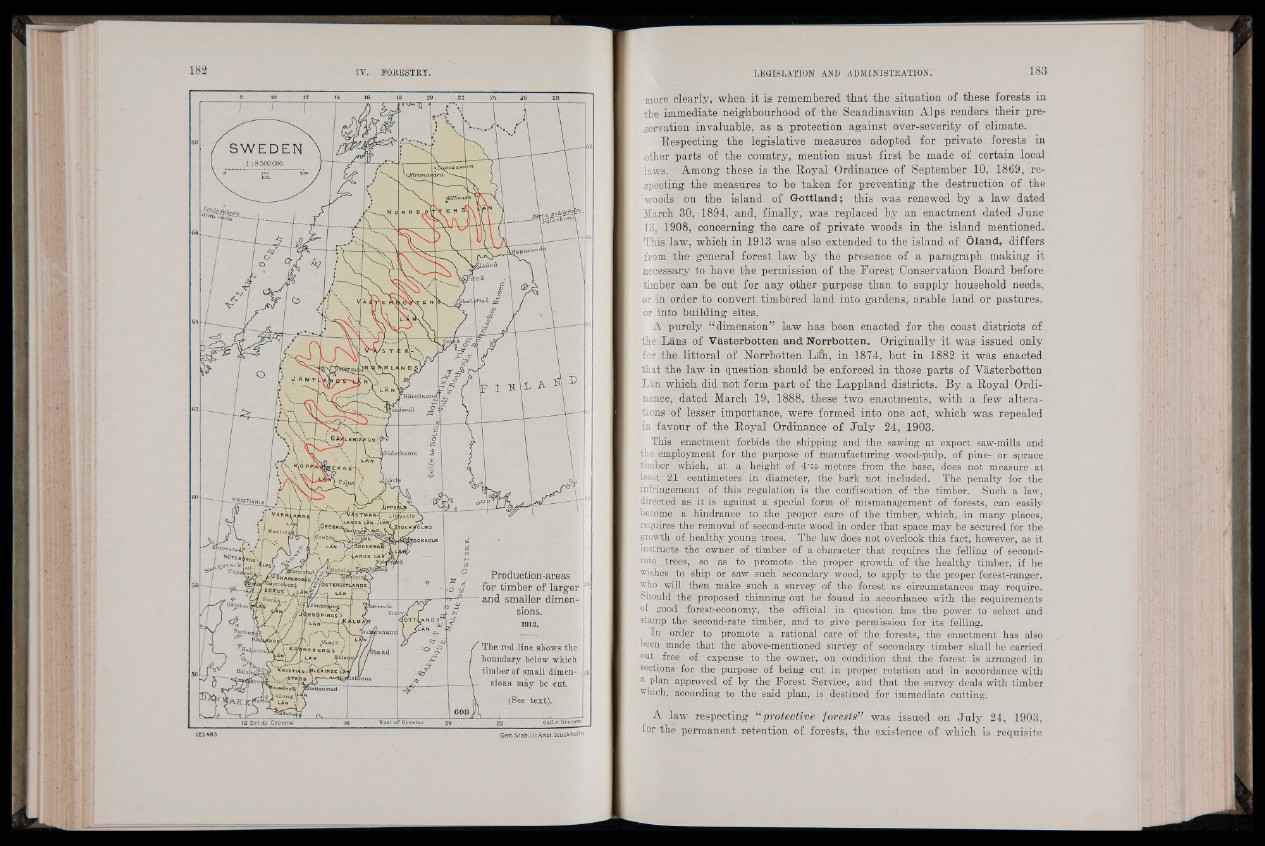
tssavo
Ske llj
IV. FORESTRY.
Harnosi
-^g»STMN| Uppsala
'.O re s ro '^
lO r e b ro_ ICKHOLM
Skaraborb
e rsb o rg J
W5"l nLAN
Produetion-areas
for timber of larger
and smaller dimensions.
1913.
ÔSTCRGOTl
fJonkbfjinjs,'"'
NKOPINOS^
The red line shows the
boundary below which
timber of small dimensions
may be cut.
‘ (iee text).
(bland
IalmohuS } °J-und. 'J
12 Est de Greenw: E a s t o f G re en y
Gen. Srab. Lit. Ansi. Stockholm
LEGISLATION AND ADMINISTRATION.
more clearly, when it is remembered that the situation of these forests in
the immediate neighbourhood of the Scandinavian Alps renders their preservation
invaluable, as a protection against over-severity of climate.
Respecting the legislative measures adopted for private forests in
other parts o f the country, mention must first be made of certain local
laws. Among these is the Royal Ordinance of September 10, 1869, respecting
the measures to be taken for preventing the destruction of the
woods on the island of Gottland; this was renewed by a law dated
March 30, 1894, and, finally, was replaced by an enactment dated June
13, 1908, concerning the care of private woods in the island mentioned.
This law, which in 1913 was also extended to the island of Oland, differs
from’ the general forest law by the presence of a paragraph making it
necessary to have the permission of the Forest Conservation Board before
timber can be cut for any other purpose than to supply household needs,
or in order to convert timbered land into gardens, arable land or pastures,
or into building sites.
A purely “ dimension” law has been enacted for the ooast districts of
the Lans of Vasterbotten and Norrbotten. Originally it was issued only
for the littoral of Norrbotten Lab, in 1874, but in 1882 it was enacted
that the law in question should be enforced in those parts of Vasterbotten
Lan which did not form part of the Lappland districts. By a Royal Ordinance,
dated March 19, 1888, these two enactments, with a few alterations
of lesser importance, were formed into one act, which was repealed
in favour of the Royal Ordinance of July 24, 1903.
This enactment forbids the shipping and the sawing at export saw-mills and
the employment for the purpose of manufacturing wood-pulp, of pine- or spruce
timber which, at, a( height of 4‘76 meters from the base, does not measure at
least 21 centimeters in diameter, the bark not included. The penalty for the
infringement of this regulation is the confiscation of the timber. Such a law,
directed as it is against a special form of mismanagement of forests, can easily
become a hindrance to the proper care of the timber, which, in many places,
requires the removal of second-rate wood in order that space may be secured for the
growth of healthy young trees. The law does not overlook this fact, however, as it
instructs the Owner of timber of a character that requires the felling of second-
rate trees, so as . to promote the proper growth of the healthy timber, if he
wishes to ship or saw such secondary wood, to apply to the proper forest-ranger,
who will then make such a survey of the forest as circumstances may require.
Should the proposed thinning out be found in accordance with the requirements
of good forest-economy, the official in question has the power to select and
stamp the second-rate timber, and to give permission for its felling.
In order to promote a rational care of' the forests, the enactment has also
been made that the above-mentioned survey of secondary timber shall be carried
out free of expense to the owner, on condition that the forest is arranged in
sections for the purpose of being cut in proper rotation and in accordance with
a Plan approved of by the Forest Service, and that the survey deals with timber
which, according to the said plan, is destined for immediate cutting.
A law respecting “protective forests” was issued on July 24, 1903,
for the permanent retention of forests, the existence of which is requisite